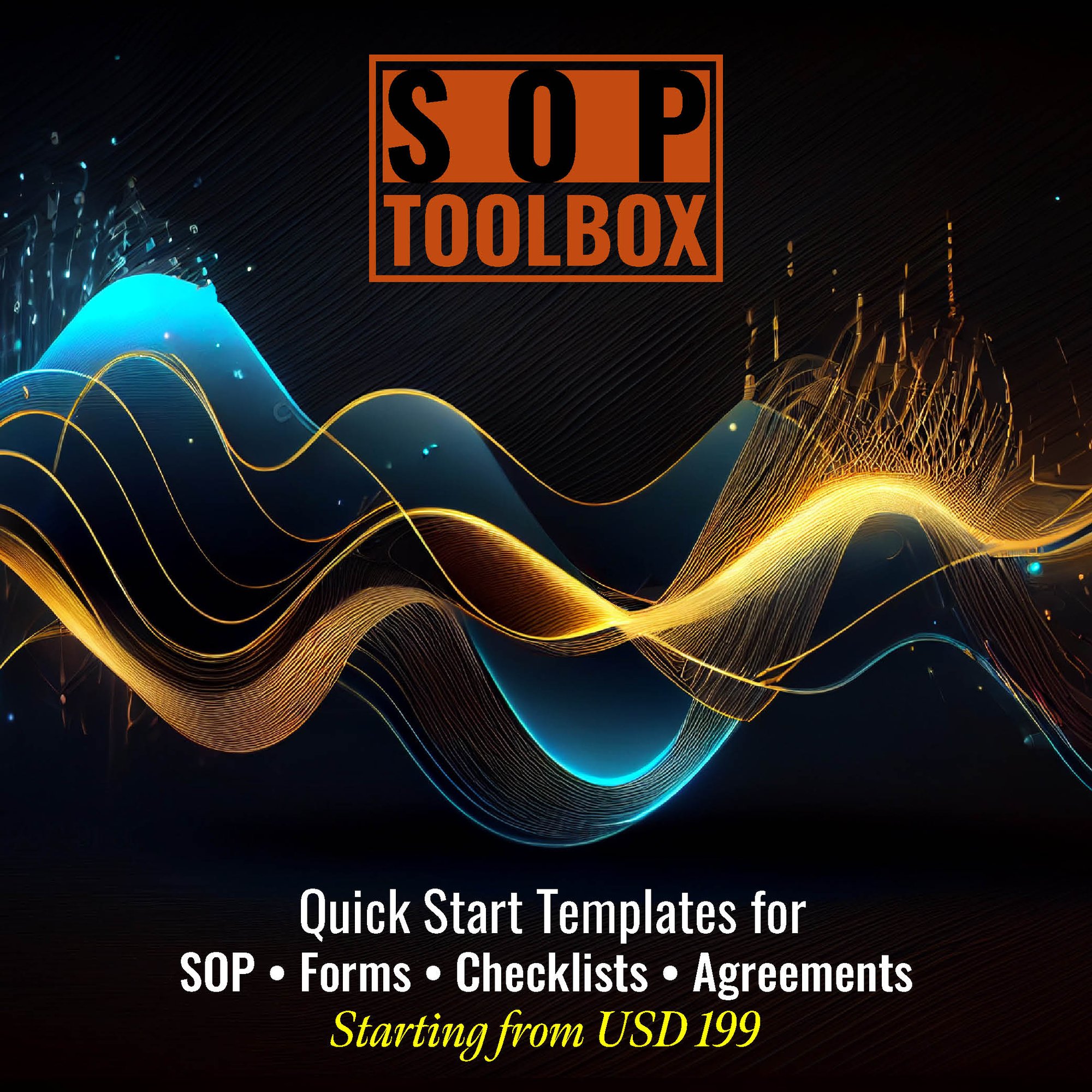The importance of an SOP (Standard Operating Procedure) Manual for Mushroom Production in the agriculture and food industry cannot be understated for several compelling reasons:
-
Quality Control: The manual establishes standardized procedures for mushroom cultivation, ensuring consistency in quality, size, and flavor. This is critical for consumer satisfaction and market competitiveness.
-
Operational Efficiency: By streamlining the cultivation process, reducing errors, and optimizing resource utilization, the manual enhances productivity, reduces production costs, and supports the profitability of mushroom farms.
-
Food Safety: Mushroom production involves the handling of perishable goods. The manual includes safety guidelines for employees, reducing the risk of contamination and ensuring safe, healthy mushrooms.
-
Regulatory Compliance: The food industry is subject to strict safety and quality regulations. The manual helps mushroom producers adhere to these regulations, reducing legal risks and potential fines.
-
Resource Management: It promotes efficient resource use, optimizing substrate and energy utilization, contributing to cost control and sustainability.
-
Innovation and Adaptation: The manual can incorporate guidelines for the cultivation of new mushroom varieties, adoption of eco-friendly practices, and emerging trends in the industry.
-
Employee Training: It serves as a valuable training resource for new employees, ensuring they quickly understand best practices, safety measures, and quality standards in mushroom production.
In summary, an SOP Manual for Mushroom Production is vital for quality control, operational efficiency, food safety, regulatory compliance, resource management, innovation, and employee training. It plays a pivotal role in the success and reputation of mushroom producers and the overall safety and quality of mushrooms in the market.
CLICK HERE to download the List of SOPs Document in PDF format. Please share this document with your clients, colleagues and senior officers.
Top 50 Standard Operating Procedures (SOPs) for Manual for Mushroom Production
SOP-1003-001: Standard Operating Procedure for Facility Preparation
SOP-1003-002: Standard Operating Procedure for Substrate Preparation
SOP-1003-003: Standard Operating Procedure for Sterilization of Substrate
SOP-1003-004: Standard Operating Procedure for Inoculation of Spawn
SOP-1003-005: Standard Operating Procedure for Mixing and Filling of Growing Bags
SOP-1003-006: Standard Operating Procedure for Casing Layer Application
SOP-1003-007: Standard Operating Procedure for Initiation of Pinning
SOP-1003-008: Standard Operating Procedure for Environmental Control
SOP-1003-009: Standard Operating Procedure for Watering and Humidity Management
SOP-1003-010: Standard Operating Procedure for Pest and Disease Control
SOP-1003-011: Standard Operating Procedure for Harvesting of Mushrooms
SOP-1003-012: Standard Operating Procedure for Post-Harvest Handling
SOP-1003-013: Standard Operating Procedure for Cleaning and Sanitization
SOP-1003-014: Standard Operating Procedure for Equipment Maintenance
SOP-1003-015: Standard Operating Procedure for Waste Management
SOP-1003-016: Standard Operating Procedure for Quality Control
SOP-1003-017: Standard Operating Procedure for Record Keeping
SOP-1003-018: Standard Operating Procedure for Staff Training
SOP-1003-019: Standard Operating Procedure for Emergency Response
SOP-1003-020: Standard Operating Procedure for Compliance with Regulatory Standards
SOP-1003-021: Standard Operating Procedure for Genetics and Strain Management
SOP-1003-022: Standard Operating Procedure for Spore Printing and Storage
SOP-1003-023: Standard Operating Procedure for Laboratory Procedures
SOP-1003-024: Standard Operating Procedure for Mycelium Isolation
SOP-1003-025: Standard Operating Procedure for Culture Maintenance
SOP-1003-026: Standard Operating Procedure for Strain Preservation
SOP-1003-027: Standard Operating Procedure for Spawn Production
SOP-1003-028: Standard Operating Procedure for Troubleshooting and Problem Resolution
SOP-1003-029: Standard Operating Procedure for Environmental Monitoring
SOP-1003-030: Standard Operating Procedure for Temperature Control
SOP-1003-031: Standard Operating Procedure for Humidity Control
SOP-1003-032: Standard Operating Procedure for Air Exchange
SOP-1003-033: Standard Operating Procedure for Light Exposure
SOP-1003-034: Standard Operating Procedure for Nutrient Supplementation
SOP-1003-035: Standard Operating Procedure for pH Management
SOP-1003-036: Standard Operating Procedure for Substrate Pasteurization
SOP-1003-037: Standard Operating Procedure for Pest Identification
SOP-1003-038: Standard Operating Procedure for Disease Diagnosis
SOP-1003-039: Standard Operating Procedure for Biological Pest Control
SOP-1003-040: Standard Operating Procedure for Chemical Pest Control
SOP-1003-042: Standard Operating Procedure for Harvest Techniques
SOP-1003-043: Standard Operating Procedure for Post-Harvest Cooling
SOP-1003-044: Standard Operating Procedure for Packaging and Storage
SOP-1003-045: Standard Operating Procedure for Transportation
SOP-1003-046: Standard Operating Procedure for Marketing and Sales
SOP-1003-047: Standard Operating Procedure for Customer Relations
SOP-1003-048: Standard Operating Procedure for Research and Development
SOP-1003-049: Standard Operating Procedure for Continuous Improvement
SOP-1003-050: Standard Operating Procedure for Business Sustainability
SOP ToolBox: If you are reading these lines, I am sure you are looking for Standard Operating Procedure guidelines or SOPs itself. In both the cases, searching in internet will not be yielding any great help. Because no company shares their SOP Development Process and certainly don’t share their SOP Documents. The best way to develop an SOP is creating one for yourself. At Fhyzics, we write SOPs day-in and day-out for companies across the globe including some of the Fortune 500 organisations. Our charge ranges from USD 5000 to USD 50000 depending upon the number of processes to be covered. Certainly, this is not affordable to small and mid-size organisations. Hence, we decided to create this SOP ToolBox to disseminate our 8-Step SOP Development Life-Cycle and best practices at an unbelievably low price.
I always say, writing an SOP is somewhere between art and science. So far you may be clueless on where to start and how to progress on an SOP? This will not be the case after you diligently go through this SOP ToolBox. We have summarised all our secrets here to get you started and to deliver a stunning SOP to your management.
-
Button Mushrooms
-
Cremini Mushrooms
-
Portobello Mushrooms
-
Oyster Mushrooms
- king Oyster Mushrooms
- Chanterelle Mushrooms
- Porcini Mushrooms
- Hedgehog Mushrooms
- Chicken of The Woods Mushrooms
- Black Trumpet Mushrooms
- Wood Blewit Mushrooms
- Morel Mushrooms
- Enoki Mushrooms
- Shimeji Mushrooms
- Shiitake Mushrooms
- Maitake Mushrooms
- Reishi Mushrooms
- Lion’s Mane Mushrooms
- Matsutake Mushrooms
- Giant Puffball Mushrooms
1. Standard Operating Procedures (SOP) Manual for Accounts Department
2.Standard Operating Procedures (SOP) Manual for Finance Department
3. Standard Operating Procedures (SOP) Manual for Customer Service
4. Standard Operating Procedures (SOP) Manual for CRM Department
5. Standard Operating Procedures (SOP) Manual for Credit Department
6.Standard Operating Procedures (SOP)Manual for Treasury Department
7.Standard Operating Procedures (SOP) Manual for Human Resources (HR) Department
8. Standard Operating Procedures (SOP) Manual for Training Department
9. Standard Operating Procedures (SOP) Manual for Learning & Development Department
10. Standard Operating Procedures (SOP) Manual for Administration Department
11. Standard Operating Procedures (SOP) Manual for Front Office
12. Standard Operating Procedures (SOP) Manual for House Keeping
13. Standard Operating Procedures (SOP) Manual for Safety Department
14. Standard Operating Procedures (SOP) Manual for Security Department
15. Standard Operating Procedures (SOP) Manual for Facilities Management Department
16. Standard Operating Procedures (SOP) Manual for Vigilance Department
17. Standard Operating Procedures (SOP) Manual for Legal Department
18. Standard Operating Procedures (SOP) Manual for Information Technology (IT) Department
19. Standard Operating Procedures (SOP) Manual for Sales & Marketing Department
20. Standard Operating Procedures (SOP) Manual for Design & Engineering
21.Standard Operating Procedures (SOP) Manual for Procurement Department
22. Standard Operating Procedures (SOP) Manual for Production
23. Standard Operating Procedures (SOP) Manual for SRM Department
24.Standard Operating Procedures (SOP) Manual for Supply Chain Department
25. Standard Operating Procedures (SOP) Manual for Warehouse
26. Standard Operating Procedures (SOP) Manual for New Product Development Department
27. Standard Operating Procedures (SOP) Manual for Research and Development
28. Standard Operating Procedures (SOP) Manual for Quality Department
29. Standard Operating Procedures (SOP) Manual for Calibration Department
30. Standard Operating Procedures (SOP) Manual for Maintenance Department
Industry Process:
Average period of mushroom cultivation and production is for 60 days, and it may also long for 150 days, where the types and varieties of mushroom determines the time period. Before initiative, the industry needs to attain a proper understanding, planning, and research in order to produce a quality and healthy mushroom. Composting is the first process involved in this industry, where animal and bio-based industrial wastes are mixed with the paddy straw, water and gypsum. In spawning process, the composite material is allowed in a tunnel at a temperature of 57-60 degrees Celsius and they stay in it for 5-6 days. Then, the mycelium is allowed and spread with the compost material for maturation process. Now the matured compost, are spread in a stainless-steel box and kept in a dark room with a temperature of about 23 degree Celsius. Between a time period of six days, 20-25 litres of water are sprinkled in it. Finally, the mycelium starts to grown to its full extent as a mushroom, and then, they are cultivated and packed for sales and distribution.
- Composting
- Spawning
- Casing
- Pinning
- Harvesting
- Quality Control and Packing
- Mushroom Dryer
- Vacuum Refrigerator
- Pawn Dozing & Bag Filling
- Water Spraying Machine
- Environmental Control System
- Compost Turner
- Bio-Compost Mixing & Bag Filling
- Straw Pasteurization Machine
- Mushroom Compost / Casing Hopper
- Composting Ahu
- Chaff Cutter
- Mushroom Tray Line
- Mushroom Casing Mixer
- Mushroom Ruffling Machine
- Composting Compost Turner
- Conveyor
- Food and Agriculture Organization- http://www.fao.org/home/en/
- ISO 7561:1984| International Organization for Standardization- https://www.iso.org/standard/14344.html
- UNECE Standard - https://www.unece.org/fileadmin/DAM/trade/agr/standard/standard/fresh/FFV-Std/English/24_CultivatedMushrooms.pdf
- Bonduelle| Villeneuve-d'Ascq, France| https://www.bonduelle.com/en/
- Costa Group| Victoria, Australia| http://costagroup.com.au/
- CMP International| Monaghan, Ireland| https://www.mushrooms.ie/
- Drinkwater Mushrooms| Lancaster, United Kingdom| https://drinkwatermushrooms.co.uk/
- Monaghan Mushrooms| Monaghan, Ireland| https://www.monaghan-mushrooms.com/
- Walsh Mushrooms Group| Gorey, Ireland| https://www.walshmushrooms.com/
- Mycelia| Deinze, Belgium| https://www.mycelia.be/en
- Smithy Mushrooms| Ormskirk, United Kingdom|https://smithymushrooms.com/
-
FUNGI Magazine-https://www.fungimag.com/
-
Mushroom Magazine- https://www.mushroom-magazine.com/
-
Mushroom Research| Connect Journals- http://www.connectjournals.com/subscription_info.php?bookmark=CJ-003989
-
The Journal of Wild Mushrooming-https://www.mushroomthejournal.com/
-
Shroom to Grow| Verve Magazine- https://www.vervemagazine.in/travel-and-spaces/shroom-to-grow-rohhaan-gawdes-the-mushroom-company-promotes-the-health-and-agricultural-advantages-of-mushrooms
-
International Journal of Medicinal Mushrooms| Begell House- https://www.begellhouse.com/journals/medicinal-mushrooms.html
-
Edible Mushrooms: Improving Human Health and Promoting Quality Life| Hindawi- https://www.hindawi.com/journals/ijmicro/2015/376387/?fbclid=iwar1pertm_0mnnlskdaq5oxbsaitjjn9ssp678s8brgxa8gckhkyn2uql6qk
Research By : Udhay Sankar
Keywords: sop, manual, policy, sop meaning, sop full form, standard operating procedure, full sop, user manual, sop is, user guide, instruction manual, owners manual, sample sop, operators manual, sop example,standard operating procedure examples, abbreviation sop, standard operating procedure sample, milk sop, sop document, sop process,m manual, operating procedures, operating process, sop meaning in hindi, standard procedure, sop standard operating procedure, sop top, sop writing, standard operating procedures manual, sop meaning in english, sample sop for mba, standard operating procedures examples in office, product manual, sample sop for ms, maintenance manual, sop security, sop in research, sop in business, whats sop, standard of operation, sop set, sop procedure, sop marketing,sop training, sop hotel, sop, sop meaning business, sop form, sba sop,sop software, help manual, sop it, army sop, company sop, sop sap, o m manual, standard operating procedure examples for small business, shop manual, sop manual, sop meaning in business, purpose of standard operating procedures, sop full meaning, standard operating procedure meaning, sop military, sop standard, sop meaning medical, hr sop, sop production, purpose of sop, sop management, warehouse sop, sales sop, sop pharma, sop manufacturing, sop creation, sop laboratory, ms sop, sop full form in hindi, sop front office, sop customer service, sop online, gmp sop, sop purchasing, sop pharmacy, sop safety, sop for project management,sample sop for australian student visa, sop meaning in tamil, sop system, best sop, sop up, sop in english, sop for mechanical engineering, sop for university,sop in malay, sop lab, sop for business analytics, sop model, sop in pharmacy, developing sops, standard operating procedure examples manufacturing, sop full form in retail,sop full form in medical, sop engineering, sop application, writing standard operating procedures, procurement sop, sop maintenance,standard operating procedure nhs, sop clinical trial, sop operations,sop in construction, operating procedures manual, standard operating procedure ppt, standard procedure meaning, sop ppt, a sop, sop document meaning, sop def, sop full form in safety, sop quality control, sop for college, sop quality, sop service, types of sop, sop for engineering management, sop document sample, benefit of sop, preparing sop, standard operating procedure in hindi, sop for visa, sop compliance, sop protocol, sop aviation, sop meaning in chat, standard operating process, sop meaning military, sop for business management, standard operating procedure software, sop list, sop medical, sop logistics, sop project, sop for it department, sop call center, standard work procedures, sba sop 50 10, sop meaning in logistics, standard operating procedure laboratory, test sop, sop sample for ms, drafting sop, sops meaning in tamil, sops meaning in telugu, sop automotive, standard operating system, sop cafe, sop slideshare, sop ap, sop bank, sop in retail, creating standard operating procedures, sop admin, document control sop, pharmaceutical sop,sop in pharmaceutical industry, statement of purpose harvard, sop examples for ms, quality assurance sop, sop in clinical research, nursing sop, sop for transportation, sop policies, sops are specific to a process, sop in hindi, standard operating procedure for warehouse picking, master sop, list of sop for pharma, pharmaceutical sop examples, types of standard operating procedures, retail sop, sample sop for ms in mechanical engineering, standard operating protocol,sop supply chain, system operating procedure, sop rules, example of sop in research, sop in food industry, sop for international business management, sop for hospitality management, sop for hr department, army sop example, sop standard operating, office sop, hr standard operating procedures, preventive maintenance sop, sop for purchase department, human resources sop, fire department sops, information technology sop, operating procedure example, administration sop,sop for retail store, indian sop, construction management sop, sop hotel front office, example sop document, standard and procedures,working sop, sop for maintenance department, sop hrd department,sop full form in hotel industry, sop full, sop for human resource management, laboratory sop examples, standard operating procedure for quality control, sop for ms in mechanical engineering, sop meaning army, security standard operating procedures, sop machine, sample sop for internship, sop for hotel management, sample sop for masters, qa sop, developing standard operating procedures, standard operating procedure document, product recall sop, marketing statement of purpose, it standard operating procedures, equipment sop, sop purpose example, sop shipping, sop for sales and marketing,converting pos to sop, workshop sop, standard operating procedure manufacturing, digital marketing standard operating procedures, following standard operating procedures, sop ki full form, sop for nursing procedures, an sop, purchase sop for manufacturing company, sop a, statement of purpose for mba marketing, full meaning of sop, sop for research internship, research sop sample,vendor qualification sop, sop purchasing and receiving, sop meaning in visa, sop for admission, standard operating procedure medical office, sop in industry, sop sales marketing, navy sop, project management standard operating procedures, sop it support, standard operating manual, security operating procedures, statement of purpose for international business, procurement standard operating procedures, communication sop, sop full form in pharma, minimum sop, sop health and safety, product sop, sop for marketing department, sop in medical terms, sales standard operating procedure, sop purchase order, department sop, customer service standard operating procedures, clinical sop, marketing standard operating procedure, sop standard operating procedure example, construction standard operating procedures, standard of operations procedures manual sample, sop for facility management, sop full form in education, standard operating procedure in food industry, visa sop,sop for business administration, company sop meaning, sop work, sop operating procedure, sop for summer internship in engineering sample, general administration sop, sop for administrative duties.
Our SOP Templates’ clients are from the following States and Countries:
Alabama, Alaska, Arizona, Arkansas, California, Colorado, Connecticut, Delaware, Florida, Georgia, Hawaii, Idaho, Illinois, Indiana, Iowa, Kansas, Kentucky, Louisiana, Maine, Maryland, Massachusetts, Michigan, Minnesota, Mississippi, Missouri, Montana, Nebraska, Nevada, New Hampshire, New Jersey, New Mexico, New York, North Carolina, North Dakota, Ohio, Oklahoma, Oregon, Pennsylvania, Rhode Island, South Carolina, South Dakota, Tennessee, Texas, Utah, Vermont, Virginia, Washington, West Virginia, Wisconsin, Wyoming.
Afghanistan, Albania, Algeria, Andorra, Angola, Antigua and Barbuda, Argentina, Armenia, Australia, Austria, Azerbaijan, Bahamas, Bahrain, Bangladesh, Barbados, Belarus, Belgium, Belize, Benin, Bhutan, Bolivia, Bosnia and Herzegovina, Botswana, Brazil, Brunei Darussalam, Bulgaria, Burkina Faso, Burundi, Cabo Verde, Cambodia, Cameroon, Canada, Central African Republic, Chad, Chile, China, Colombia, Comoros, Congo (Republic of the), Costa Rica, Croatia, Cuba, Cyprus, Czech Republic (Czechia), Democratic People’s Republic of Korea (North Korea), Democratic Republic of the Congo, Denmark, Djibouti, Dominica, Dominican Republic, Ecuador, Egypt, El Salvador, Equatorial Guinea, Eritrea, Estonia, Eswatini, Ethiopia, Fiji, Finland, France, Gabon, Gambia, Georgia, Germany, Ghana, Greece, Grenada, Guatemala, Guinea, Guinea-Bissau, Guyana, Haiti, Honduras, Hungary, Iceland, India, Indonesia, Iran, Iraq, Ireland, Israel, Italy, Jamaica, Japan, Jordan, Kazakhstan,Kenya, Kiribati, Kuwait, Kyrgyzstan, Lao People’s Democratic Republic (Laos), Latvia, Lebanon, Lesotho, Liberia, Libya, Liechtenstein, Lithuania, Luxembourg, Madagascar, Malawi, Malaysia, Maldives, Mali, Malta, Marshall Islands, Mauritania, Mauritius, Mexico, Micronesia (Federated States of), Moldova, Monaco, Mongolia, Montenegro, Morocco, Mozambique, Myanmar (Burma), Namibia, Nauru, Nepal, Netherlands, New Zealand, Nicaragua, Niger, Nigeria, North Macedonia (formerly Macedonia), Norway, Oman, Pakistan, Palau, Panama, Papua New Guinea, Paraguay, Peru, Philippines, Poland, Portugal, Qatar, Republic of Korea (South Korea), Republic of the Congo, Romania, Russian Federation (Russia), Rwanda, Saint Kitts and Nevis, Saint Lucia, Saint Vincent and the Grenadines, Samoa, San Marino, Sao Tome and Principe, Saudi Arabia, Senegal, Serbia, Seychelles, Sierra Leone, Singapore, Slovakia, Slovenia, Solomon Islands, Somalia, South Africa, South Sudan, Spain, Sri Lanka, Sudan, Suriname, Sweden, Switzerland, Syrian Arab Republic (Syria), Tajikistan, Thailand, Timor-Leste, Togo, Tonga, Trinidad and Tobago, Tunisia, Turkey, Turkmenistan, Tuvalu, Uganda, Ukraine, United Arab Emirates, United Kingdom of Great Britain and Northern Ireland, United Republic of Tanzania, United States of America, Uruguay, Uzbekistan, Vanuatu, Venezuela, Viet Nam, Yemen, Zambia, Zimbabwe.
Fhyzics supports organisations in developing the following documentations:
Standard Operating Procedures (SOPs), Work Instructions, Policies and Procedures, Process Flow Diagrams, Job Descriptions, Training Manuals, Employee Handbooks, Compliance Guidelines, Quality Assurance Manuals, Health and Safety Procedures, Risk Management Plans, Business Continuity Plans, Internal Audit Procedures, Incident Reporting Forms, Performance Management Guidelines, Change Management Procedures, Vendor Management Guidelines, Customer Service Protocols, IT Security Policies, IT Support Documentation, Disaster Recovery Plans, Operational Checklists, Data Management Policies, Confidentiality Agreements, Non-Disclosure Agreements, Employee Onboarding Procedures, Employee Exit Procedures, Performance Appraisal Forms, Employee Code of Conduct, Conflict Resolution Procedures, Product Development SOPs, Supply Chain Management Guidelines, Procurement Guidelines, Inventory Management SOPs, Shipping and Receiving Procedures, Production Scheduling SOPs, Maintenance Procedures, Equipment Calibration Documents, Environmental Compliance Documentation, Sustainability Policies, Customer Feedback Forms, Marketing Strategies, Advertising Guidelines, Brand Management Guidelines, Product Packaging SOPs, Laboratory Testing Procedures, Regulatory Compliance Documentation, Tax and Accounting Procedures, Contract Management Procedures, Legal Compliance Guidelines, Financial Reporting Procedures, Budgeting Procedures, Internal Control Procedures, Fraud Prevention Policies, Asset Management Guidelines, Purchase Order Procedures, Sales and Distribution Guidelines, Client Contracts, Customer Return Policies, Internal Communication Protocols, Vendor Evaluation Forms, Product Safety Standards, Workplace Health and Safety Standards, Public Relations Procedures, Social Media Management Guidelines, Crisis Management Plans, Employee Grievance Procedures, Privacy and Data Protection Policies, Digital Transformation Guidelines, Innovation Management Procedures, Continuous Improvement Guidelines, Strategic Planning Documents, Corporate Social Responsibility (CSR) Guidelines, Audit Trails and Records, Employee Training and Development Records, Succession Planning Documents, Talent Acquisition Procedures, Team Collaboration Protocols, Employee Benefit Plans, Workplace Diversity Guidelines, Time and Attendance Tracking, Payroll Procedures, Employee Leave Policies, Conflict of Interest Policy, Emergency Response Procedures, Environmental Impact Assessment Procedures, Transportation and Logistics Procedures, Inventory Control Forms, Warehouse Management Guidelines, Product Lifecycle Management SOPs, Customer Satisfaction Surveys, Third-Party Risk Assessment Guidelines, Technology Adoption Policies, Software Licensing Guidelines, Security Incident Response Procedures, Supply Chain Risk Management Policies, Product Recall Procedures, Food Safety Guidelines, Employee Wellness Programs, Workplace Ergonomics Guidelines.






.jpg?width=645&height=337&name=Standard%20Operating%20Procedure%20-%20SOP%20ToolBox%20(1).jpg)











